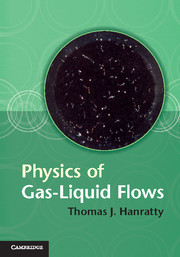Book contents
- Frontmatter
- Contents
- Preface
- List of Symbols
- 1 One-dimensional analysis
- 2 Flow regimes
- 3 Film flows
- 4 Inviscid waves
- 5 Stratified flow
- 6 Influence of viscosity on large Reynolds number interfacial waves; effect of spatially and temporally induced oscillations on a turbulent flow
- 7 Large-wavelength waves; integral equations
- 8 Bubble dynamics
- 9 Horizontal slug flow
- 10 Particle dispersion and deposition
- 11 Vertical annular flow
- 12 Horizontal annular flow
- Index
- References
8 - Bubble dynamics
Published online by Cambridge University Press: 05 November 2013
- Frontmatter
- Contents
- Preface
- List of Symbols
- 1 One-dimensional analysis
- 2 Flow regimes
- 3 Film flows
- 4 Inviscid waves
- 5 Stratified flow
- 6 Influence of viscosity on large Reynolds number interfacial waves; effect of spatially and temporally induced oscillations on a turbulent flow
- 7 Large-wavelength waves; integral equations
- 8 Bubble dynamics
- 9 Horizontal slug flow
- 10 Particle dispersion and deposition
- 11 Vertical annular flow
- 12 Horizontal annular flow
- Index
- References
Summary
Prologue
A central issue to be addressed in analyzing the behavior of bubbles in a gas–liquid flow is understanding the free-fall velocity of a spherical solid particle and the rise velocity of a spherical bubble in an infinite stationary fluid. Analytical solutions for these systems are available for very low particle Reynolds numbers (Stokes law and the Hadamard equation). A derivation of Stokes law is presented in the first part of this chapter.
Experiments show that Stokes law is valid for particle Reynolds numbers less than unity. For larger ReP, empirical correlations of the drag coefficient are used. The description of the rise velocity of bubbles is complicated by possible contamination of the interface. Measurements of the rise velocity of single bubbles are usually presented as plots of US versus the bubble size for a given system. The structure of these plots reflects changes in the shape and behavior of the bubbles. Very large bubbles take the shape of a cap. A prediction of the rise velocity of these cap bubbles, developed by Batchelor, is presented in Section 8.7.
Information
- Type
- Chapter
- Information
- Physics of Gas-Liquid Flows , pp. 173 - 201Publisher: Cambridge University PressPrint publication year: 2013
